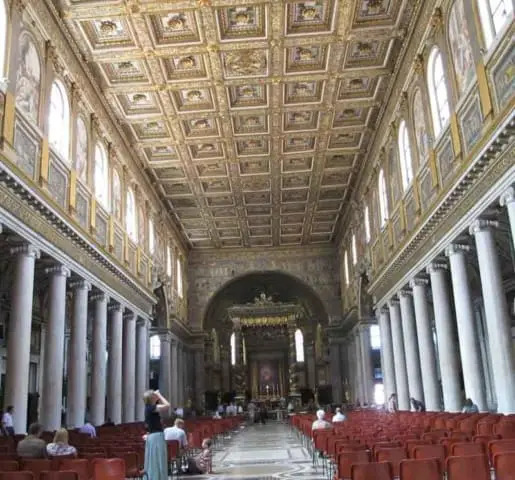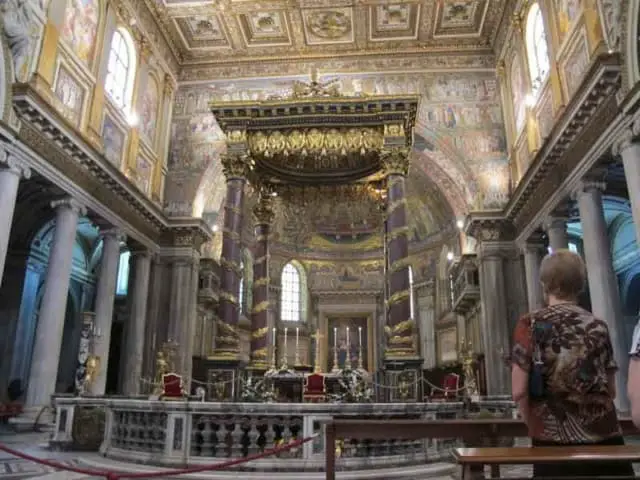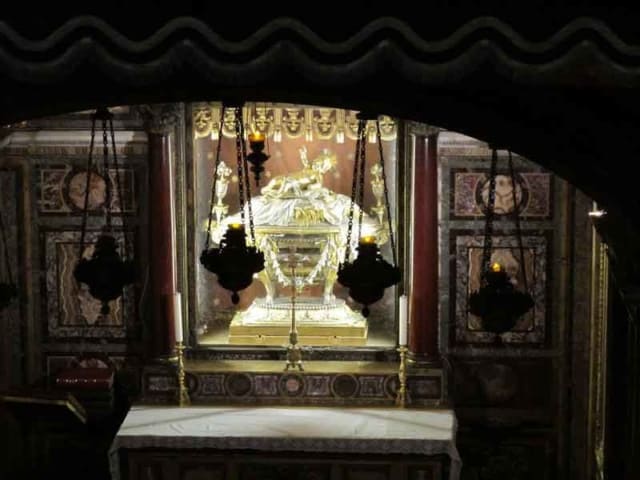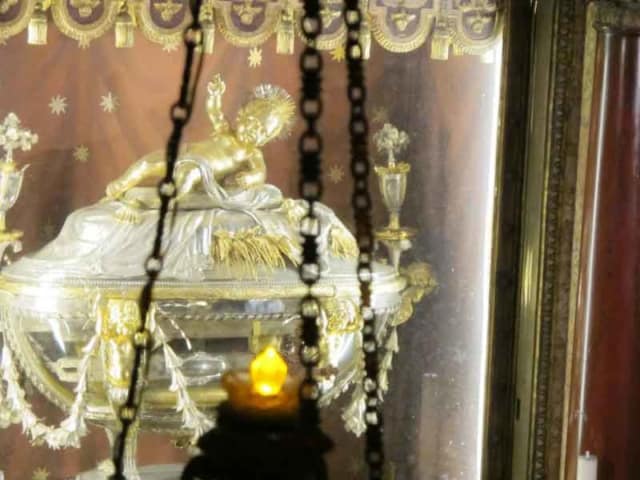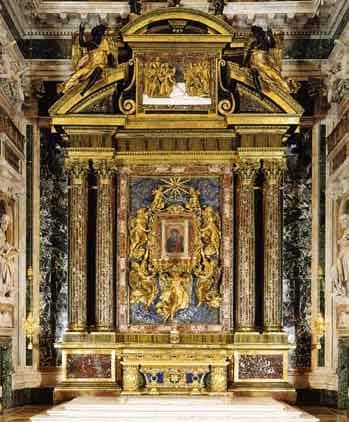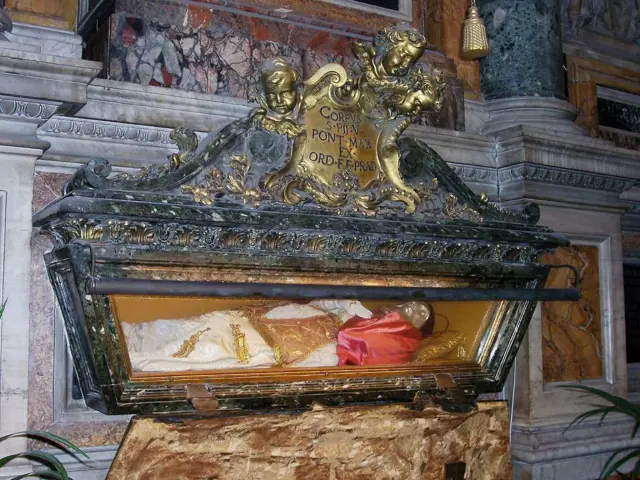Rome: The Basilica of St. Mary Major (Our Lady of the Snows)
The history of the Basilica of Saint Mary Major:
This basilica is one of the oldest and most important shrines in the world dedicated to the Blessed Virgin Mary. In fact, it was built at her request!
According to tradition, a Roman Patrician, Giovanni and his wife, were childless and prayed to the Blessed Mother that she would designate an heir for them to bequeath their wealth. They had a vision in which the Blessed Mother told them that she wished to have a church built in her honor on the Esquiline Hill and the sign to verify this dream the prospective layout of the church would be outlined in snow.…..this in the month of August!
When Giovanni approached his friend, Pope Liberius, with this news he was amazed to find out that on the night of August 4th, 352, the Virgin Mary had appeared to Pope Liberius (352-366) as well. She said a miraculous snowfall would occur that would outline where the church was to be built in her honor.
The next day August 5th, snow indeed did fall on the Esquiline Hill in Rome in the middle of a heat wave. The people staked off the outline of the future Basilica before the snow could melt. Pope Liberius immediately ordered the basilica to be built.
The event provided us with one of Our Lady’s oldest titles, Our Lady of the Snows.
About the Basilica of Saint Mary Major:
St. Mary Major contains some the finest artwork and architectural wonders in the world. The ceiling is a masterpiece of the Renaissance and the work of Giuliano da Sangallo. It is gilded with the first gold brought to Spain from the New World by Christopher Columbus as a present to Pope Alexander VI from Ferdinand and Isabella of Spain.
There are two especially noteworthy Christian treasures in this basilica:
The most notable is a relic of the manger from Bethlehem in which the baby Jesus was lain. This is venerated under the High Altar of the Basilica. Facing this magnificent relic is a marble statue of Pope Pius IX, who proclaimed the dogma of the Immaculate Conception in 1854.
The second is the painting of the Blessed Mother known as the Salus Populi Romani, (The Salvation of the Roman People) for the exceptional devotion, which the people of Rome have for this image of the Virgin. Tradition attributes the painting to St. Luke. This image had been brought back from the Holy Land by St. Helena, mother of the Emperor Constantine. During the pontificate of Pope St. Gregory the Great (590-604) a plague attacked the people of Rome and the Pope carried the image in procession to pray to their Protectoress for an end to the plague. When the plague ended, the pontiff solemnly placed crowns of gold and gems on the heads of Mary and the child Jesus on the miraculous image.
Pope Francis, the day after his election as Pope, visited Saint Mary Major to pay tribute to the Blessed Mother and to pray at this same altar. And he often visits here, especially before and after any foreign trips.
An ancient gift: The Golden Rose presented to Salus Populi Romani
On December 8, 2023, the Feast of the Immaculate Conception, Pope Francis venerated Our Lady with a Golden Rose for the Marian icon of the Salus Populi Romani in the Basilica of St. Mary Major. This historic gesture had not been performed in 400 years. The Golden Rose has ancient roots, symbolizing the papal blessing, and the tradition of this gift dates back to the Middle Ages. Over the centuries, it has been given to monasteries, shrines, sovereigns, and prominent personalities in recognition of their commitment to faith and the common good.
As explained by a statement issued by the Basilica, with the gift of the Rose to the Salus Populi Romani, “Pope Francis highlights the spiritual importance and profound significance that this icon holds in the life of the Catholic Church, as it is also the oldest Marian shrine in the West dedicated to the Mother of God.”
Also of interest is the altar in the Sistine Chapel (not the same as the one in Saint Peter’s, of course) at which Saint Ignatius of Loyola, founder of the Jesuits, celebrated his first Mass on Christmas Eve, 1538.
And another point of interest is the head of Saint Pancras. A 14-year-old orphan who had converted to Christianity, he was brought to Rome by his uncle, Saint Dionysius. He was martyred along with Saint Nereus, Saint Achilleus, and Saint Domitilla for publicly proclaiming his faith around 304 AD. Some of his relics found were taken to England, where you will find many churches are dedicated to him.
The liturgical Feast of the Dedication of the Basilica of Saint Mary Major is celebrated each year on the 5th of August. At the conclusion of the Solemn Mass of that day a shower of white rose petals falls from the dome of the Chapel of Our Lady where the image is kept. A beautiful custom is kept to remember the miraculous snowfall. Here is a video of that event
Six Popes are entombed in the Basilica of Saint Mary Major:
Pope Honorius III (1150-1227): considered among the finest administrators in the history of the Catholic Church. During his 11 years in the office, Honorius III tackled church reform, brought peace to various conflicts, and worked to organize a massive Fifth Crusade to the Holy Land.
Pope Nicholas IV (1227-1292): He was the first Franciscan pope, and in loving remembrance of Nicholas III he assumed the name of Nicholas IV.
Pope St. Pius V (1504-1572): whose decision to keep wearing his white Dominican habit led to the custom of the pope wearing a white cassock that continues to this day….We celebrate the Feast Day of Pope Saint Pius V on April 30.
Pope Sixtus V (1521-1590): who is noted for implementing the Council of Trent.
Pope Clement VIII (1536-1605): reformer in the mold of the Counter Reformation. He worked hard to improve education and discipline within the clergy. He visited all of the churches in Rome with the purpose of rooting out abuses. He revised the Vulgate, the Latin Bible, and the breviary and missal.
Pope Clement IX (1600-1669)
In December 2023, Pope Francis mentioned that he wished to be entombed here as well, rather than at Saint Peter’s Basilica.
In addition, the Basilica contains the tomb of Saint Jerome:
A Doctor of the Church, It was Saint Jerome who translated the Bible from Greek to Latin in what became known as the “vulgate” bible. Saint Jerome did most of his translation in the Cave of Saint Jerome in Bethlehem before his death in 420 AD. His body was later moved to Constantinople and then finally here to the Basilica of Saint Mary Major. It is uncertain whether they are under the Papal Altar within the main body of the church or within the confessio of the chapel in the right transept.
Check their website for the complete liturgical schedule.
Finding the Basilica of Saint Mary Major:
For help finding your way around, we suggest the “Little Black Book of Rome” It is organized by location rather than alphabetically like so many guide books. And we also suggest you carry a “Streetwise Map of Rome” for easy navigating.
Address: Piazza di S. Maria Maggiore, 42, 00100 Roma RM, Italy
GPS coordinates: 41° 53′ 51.3564” N, 12° 29′ 54.2688” E
Fax for group reservations: +39 06 6988 6817
Click here for the official and well-detailed site of the Basilica of Saint Mary Major
After your visit here you might want to walk over nearby to the Church of Santa Prudenzia….considered to be the oldest church in Rome.
⇐ Back to Catholic shrines & places of interest in Rome

